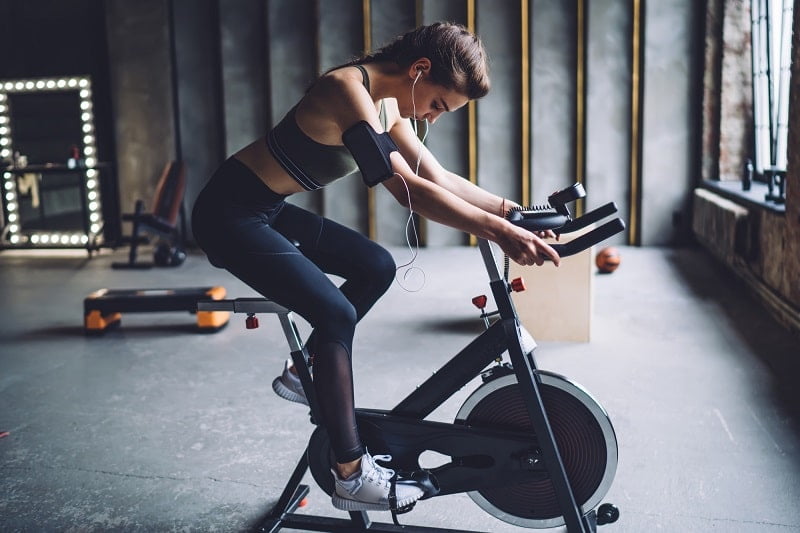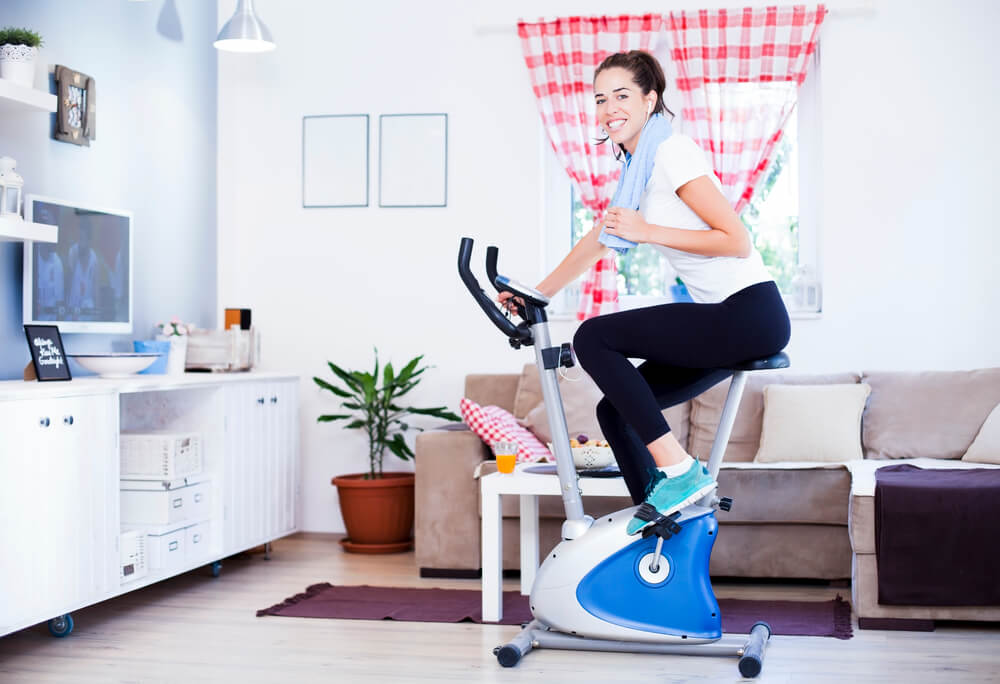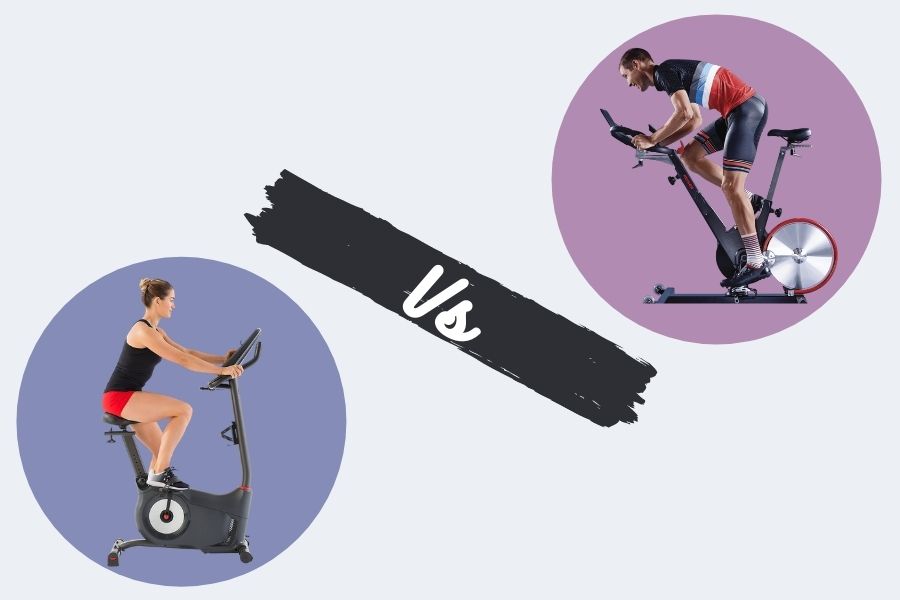Stationary bikes are a popular piece of equipment for your home gym. If you’ve searched the market, you’ll know there are many different types of stationary bikes. Some of the most popular include indoor cycles and upright bikes. Throughout this article, we’re going to discuss their differences and help you decide which is best for you.
Indoor Cycle / Spin® Bike

What Is It?
Indoor cycles, also known as Spin® bikes, became popular in the early ’90s. The significant rise in Spin® classes boomed the indoor cycle industry. Indoor cycles are designed to mimic the feeling of being on a real-life road bike. If you closed your eyes, you wouldn’t notice the difference between the two. The cycling motion of an indoor cycle is very like that of a road bike. The handlebars are also very similar between the two. There are many hand positions to support you in a range of positions, including standing. So, if you’re using your indoor cycle to supplement your road bike training, it’s an effective crossover.
Yet, unlike real-life road bikes, indoor cycles contain a heavy flywheel. The flywheel is connected to the pedals via a chain. Resistance on the flywheel can be adjusted to mimic the resistance experienced on a road bike. Three of the most popular forms of resistance are magnetic, friction, or a hybrid of both. The resistance is adjusted via a crank or knob. Increasing the resistance brings the pads or magnets closer to the flywheel, thus increasing the difficulty.
Higher-end indoor cycles are compatible with a range of apps and programs. Programs guide you through a range of Spin® style classes. If you’re unsure how to train or need some extra motivation, joining a class is a great option. Better yet, you can do it in the comfort of your own home without having to work out in a room full of sweaty people.
Indoor Cycles: Pros & Cons
Stationary/Upright Bike

What Is It?
Upright bikes are like the indoor cycle’s predecessor. They’ve been around for a long time and have evolved over the years. As the name suggests, your body is placed in an upright position during cycling. Some people find an upright position more comfortable. Many users say less strain is placed on their lower back.
Many upright bikes are foldable. If you live in a small apartment or don’t have much room to spare, they can be a great space-saving option. Foldable upright bikes can be stored in a spare cupboard or the corner of a room.
Most upright bikes are manufactured using a crankshaft and bottom bracket, which turns the flywheel via a chain or belt. Upright bikes use either electromagnetic, magnetic, or fan resistance. Upright bikes usually include features such as calories burned, heart rate, distance, and speed. Additionally, some have many preset programs that take you through a guided session. Another great feature of the upright bike is its wide, comfortable seat.
Indoor Cycles: Pros & Cons
Differences

Resistance
Indoor cycles mimic the action of a road bike but contain a heavy flywheel instead of wheels. Resistance is generated by magnets, friction, or a combination of both. When the resistance is adjusted the pads or magnets move closer or further from the flywheel, thus changing the difficulty. The heavy flywheel makes it feel like a real bike. Upright bikes also use flywheels, but they’re much lighter. Upright bikes use either electromagnetic, magnetic, or fan resistance. Since the flywheel is much lighter, the motion feels a bit abnormal.
Related
Magnetic vs Friction Resistance Exercise Bikes
Seated Position
Indoor cycles put your body in the optimal position for riding. The seat on an indoor cycle is higher than the handlebars, thus you’ll adopt a slight leaning position. This position is also what you’ll experience on a road bike. You can make many adjustments to the seat and handlebars to ensure your bike is in the best position for your body. On the other hand, the handlebars on an upright bike are much higher than the pedals. Consequently, you’ll be sat in an upright position while pedaling. Some people prefer an upright position as it helps support good posture. But, this position is not optimal for performance. Thus, if you’re looking to perform on the bike, an indoor cycle will be more suitable.
Gadgets
Gadgets will depend on the model. Many upright bikes contain a monitor that displays calories burned, heart rate, distance, and speed. These metrics are useful when you have specific training goals. Heart rate is particularly useful when aiming for different exercise intensities. Additionally, many upright bikes contain pre-set programs to help guide you through a workout. Many indoor cycles do not display calories burned, heart rate, distance, and speed. But, some models are compatible with various apps and programs that take you through a typical Spin® style session. This is a great feature for those who need a bit of extra motivation during a workout.
Handlebars
The handlebars on an indoor cycle are like the ones you’d find on a road bike. There are many hand positions to support you in a range of positions, including standing. Conversely, upright bikes only have two hand positionings. Additionally, upright bikes do not support standing while pedaling.
Space
Indoor cycles can be a bit bulky, therefore need a fair amount of room. Upright bikes are of a similar size, but many models are foldable. Thus, you’ll only need a bit of space when you’re using the bike. Foldable upright bikes can be stored in a cupboard or corner of a room when not in use. If you live in an apartment or have limited space, a foldable upright bike might be a better option.
Seat
Indoor cycles contain a seat like what you’d find on a road bike. The seat is narrow and firm. A narrow seat allows your legs to reach full extension, thus aids performance. Additionally, narrow seats help prevent chafing during longer rides. Conversely, upright bikes provide a wide, padded seat. Many people find this more comfortable but finds it impacts their ability to reach full extension. Seat preferences very much depend on the person. If you find the seat is uncomfortable, there are many seat covers available to ensure you experience a comfortable ride.
Pedals
The main difference between the pedals is indoor cycles are generally compatible with clip-on shoes. Securing your foot to the pedal can help exert more power through the pedals and thus aid performance. Pedals on an upright bike are typically limited to a strap. If performance isn’t your primary concern, this should not be a problem.
Price
Price varies between low- and high-end models for both the indoor cycle and upright bikes. But, generally speaking, upright bikes are cheaper than indoor cycles.
FAQ’s
Which Is Better a Spin® Bike / Indoor Cycle or Exercise Bike?
Can You Use a Spin® Bike / Indoor Cycle as a Normal Exercise Bike?
Verdict: Which is the best for me?
Which bike is best for you very much depends on your needs and wants from your bike. Indoor cycles are best suited to those who want a Spin® class experience or want an indoor alternative for their road bike training. Indoor cycles are designed for performance. They should be considered by serious athletes and cyclists. Upright bikes are better for recreational athletes looking to improve their health and fitness. Their upright position provides much more comfort. They’re perfect for someone looking to add in a bit of exercise while they watch TV.
